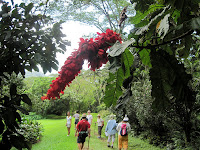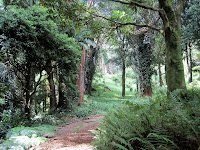

Hala trees at Manoa Elementary School
 The Hala Tree which is prevalent throughout the Pacific must have floated its way to Hawaii many years ago. Yes, the hala seeds float. It is also known as the pandanus tree which I am sure many of you have heard of. It is very unique looking, growing as tall as 20 feet with aerial roots, meaning that you can see the roots sticking out above the ground. The Hala Tree thus has the nickname of “walking tree” because it looks like it has legs. Another interesting fact is that it represents the Hawaiian family. A mother would refer to the roots as her children with the parents being the trunk.
The Hala Tree which is prevalent throughout the Pacific must have floated its way to Hawaii many years ago. Yes, the hala seeds float. It is also known as the pandanus tree which I am sure many of you have heard of. It is very unique looking, growing as tall as 20 feet with aerial roots, meaning that you can see the roots sticking out above the ground. The Hala Tree thus has the nickname of “walking tree” because it looks like it has legs. Another interesting fact is that it represents the Hawaiian family. A mother would refer to the roots as her children with the parents being the trunk. The Native Hawaiians used the entire tree in many ways. Lauhala, the hala leaves which are long and bent, were woven to make roofs, hats, mats, pillows, fans, baskets and canoe sails. Bags, slippers and placemats are popular items today. This craft was very important to the history and culture of Hawaii because it produced many of the items needed to live on the islands long ago. The leaves were dethorned, washed, baked in the sun so that the leaves will turn into a beautiful tan color, rolled into coils and then stripped to whatever size that was needed.
The Native Hawaiians used the entire tree in many ways. Lauhala, the hala leaves which are long and bent, were woven to make roofs, hats, mats, pillows, fans, baskets and canoe sails. Bags, slippers and placemats are popular items today. This craft was very important to the history and culture of Hawaii because it produced many of the items needed to live on the islands long ago. The leaves were dethorned, washed, baked in the sun so that the leaves will turn into a beautiful tan color, rolled into coils and then stripped to whatever size that was needed. 

Female hala produce pineapple looking fruits in the center of the fronds. Each cluster is made of 50 or more sections called “keys.” The fibers on the inner ends of the dry keys were used as brushes for painting kapa. The narrow inner ends of the hala keys are starchy and have been used as food, not so much in Hawaii, because taro and breadfruit were abundant, but in Micronesia.

The ends of the unripe hala fruit can also be strung with lauae fern to make leis. These leis can be considered both lucky and unlucky. The Hawaiian word hala besides meaning “pandanus” also means “slip, error or mistake.” Wearing a hala lei at New Year's is lucky because the old year is slipping away. But at other times it is very unlucky, especially for hula dancers and those who are doing business.
Male hala produced a white, fragrant flower called Hinano. You may be familiar with Hinano Beer made in Tahiti. The logo is of a young lady with hinano flowers in her hair. The pollen was used to preserve feathers and leis. The pollen was also used by Hawaiian girls as a love charm. I’m really not sure what that means but I am assuming that the girls put the fragrant pollen on themselves to win attract their significant other. The male flowers were also crushed and blended with coconut oil to be used as a laxative.
The wood of the tree was used to make water pipes, posts and calabashes.
The tips of the roots were made into a tonic to cure a tuberculosis skin infection of the neck. I find it amazing that the Native Hawaiians were so knowledgeable about such things.
The hala and lauhala are still used for many of the purposes that I have explained in this article. However many of the groves that were present many years ago are no longer in existence. They have been cleared for building homes and for farming. Famous hala groves can be seen in the Puna district on the Big Island, the Hana coast in Maui and Naue in Kauai. The plants make great landscape and can also be grown indoors.
Once again the Native Hawaiians utilized another plant to its maximum capacity and we are fortunate today because of that. Aloha.

































































































